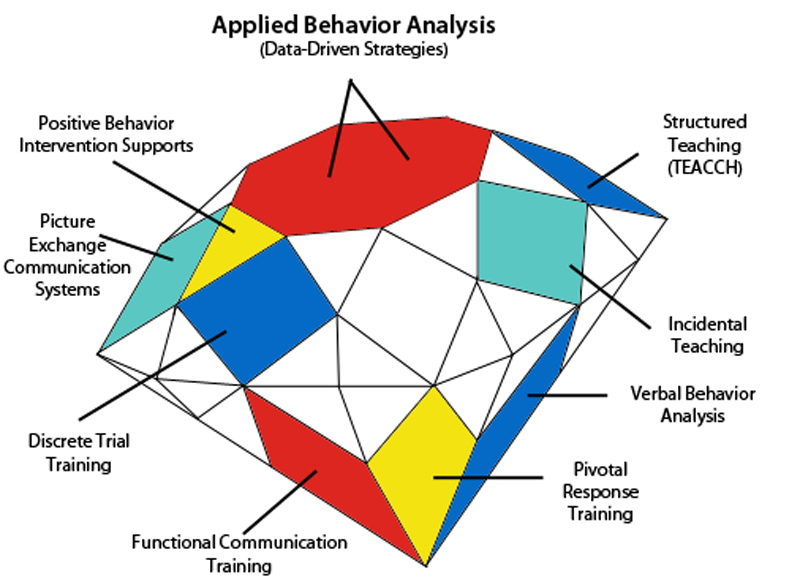Section 5: Treatment and Intervention
165 A Focus on Applied Behavior Analysis (ABA)
The gold standard in ASD intervention
What is behavior?
Human behavior is made up of actions that can be specifically described, observed, and measured. Our behavior can be described in many ways. Conscious behavior includes behaviors like eating, walking, and driving. Unconscious behavior includes things like breathing, reflex responses, and blinking. There are many ways to describe and categorize behavior, some of which include voluntary and involuntary, social and anti-social, adaptive and maladaptive, and functional and nonfunctional. The basic goal of scientists who study behavior is to observe, describe, understand, explain, and predict behavior.
What are behavioral therapies?
Behavioral therapy is a broad term referring to the general application and use of behavioral principles and interventions. The term can be used to describe a number of behavioral philosophies, methods and treatments used to address concerns relating to behavioral excesses and deficits. However, the methods and interventions often may be prescribed as a result of clinical judgment (often informed by behavioral research) of the therapist guiding intervention as opposed to a scientific and methodical data driven decision making process inclusive of hypothesis testing, systematic implementation of strategies or ongoing analyses of outcomes.
What is Applied Behavior Analysis (ABA)?
ABA is a philosophy that involves the scientific and systematic application of methods based upon behavioral principles. It is the philosophy adhered by the HANDS in Autism® training model. Such a scientific and data driven approach to intervention has been shown to be effective with a wide variety of behavioral disorders and symptoms. Importantly, it has been effective when applied to working with individuals with autism spectrum disorder (ASD) in that intervention is focused on setting up the environment, reducing behavioral symptoms, and increasing functional replacement skills.
Applied Behavior Analysis (ABA)…
- IS representative of a clear and systematic way to describe, observe, & measure behavior
- IS a science that uses very specific information about behavior to choose interventions to improve socially significant behavior
- IS a research-based (or evidence-based) philosophy
- IS based on applied & functional goals
- IS involving data-driven assessment & intervention
- IS supportive of teaching both simple and complex skills
- IS supportive of an individualized approach to addressing strengths & weaknesses of individuals
- IS focused on increasing maintenance, generalization, & independence
- IS a philosophy that reinforces 24/7 opportunities for teaching
- IS a set of tools, the specific combination of which is determined based upon individual needs
Applied Behavior Analysis (ABA) is…
- NOT a specific method for treating autism or other developmental disorders
- NOT equivalent to any one strategy following ABA principles (e.g., Discrete Trial Training (DTT), Verbal Behavior Analysis (VBA))
- NOT increase dependence on others
- NOT invalidated due to the focus on one child at a time (single case study)
- NOT just useful for clinic settings
- NOT applied to all behaviors, just those behaviors which are socially inappropriate
- NOT only used for behavior reduction
- NOT based on aversive (punishment)
- NOT based on manipulating people
- NOT just simple stimulus-response training
- NOT effective if used for only a few minutes a day
- NOT exclusive to the treatment of autism

Intervention strategies consistent with an evidence-based ABA approach
Proactive Strategies:
- Visual/Physical Structure
- Social Stories
Skills Teaching Strategies:
- Errorless Learning
- Guided Compliance
- Task Analyses
- Video Modeling
Consequence-based strategies:
- Differential Reinforcement
- Planned Ignoring
- Token Systems
- Response Cost Systems
- Time Out
- Over-correction
*this list is only representative and should not be considered to be exhaustive of all possible interventions within the framework of an ABA philosophy. All noted strategies are central to the comprehensive framework, curriculum and process of the HANDS in Autism® Model
References
Baer, D. M., Montrose, M. W., Risley, T. R. (1968). Some current dimensions of the applied behavior analysis. Journal of the Association for Behavior Analysis, 1, 91-97.
Baer, D. M., Wolf, M. M., Risley, T. R. (1987). Some still-current dimensions of applied behavior analysis. Journal of the Association for Behavior Analysis, 20, 3131-327.
Iovannone, R., Dunlap, G., Huber, H., & Kincaid, D. (2003). Effective Educational Practices for Students with Autism Spectrum Disorders. Focus on Autism and Other Developmental Disabilities, 18(3), 150-165.
Lonigan, C., Elbert, J., & Johnson, S. (1996). Empirically supported psychosocial interventions for children: An overview. Journal of Clinical Child Psychology, 27(2), 138-145.
Matson, J., Benavidez, D., Compton, L., Paclawskyj, T., & Baglio, C. (1996). Behavioral treatment of autistic persons: A review of research from 1980 to the present. Research in Developmental Disabilities, 17(6), 433-465.
Posey, D. (2007). Key points on medication for Autism Spectrum Disorders, Indianapolis, IN: Christian Sarkine Autism Treatment Center, Riley Child & Adolescent Psychiatry Clinic.
Rogers, S. (1998). Empirically supported comprehensive treatments for young children with autism. Journal of Clinical Child Psychology, 27(2), 168-179.
